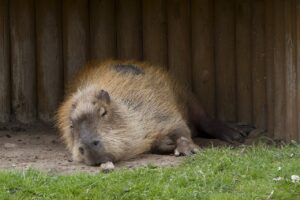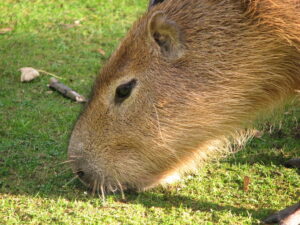Capybaras, the largest rodents in the world, have a unique diet that fascinates animal lovers and scientists alike. These social animals, native to South America, have adapted to a herbivorous lifestyle that plays a crucial role in their survival and well-being. Understanding what capybaras eat sheds light on their digestive system, feeding behaviors, and overall health in both natural habitats and captivity.
The capybara diet consists mainly of grasses, aquatic plants, fruits, and vegetables. Their feeding habits are closely tied to their semi-aquatic nature, as they often graze near water sources. This article will explore the nutritional needs of capybaras, their feeding ecology in the wild, and the challenges of maintaining a proper diet in captivity. By examining what capybaras eat, we can gain insights into their role in ecosystems and how to best care for them in human-managed environments.
Capybara’s Herbivorous Lifestyle
Capybaras are true herbivores, with their diet consisting almost exclusively of plant matter. These large rodents have adapted to a lifestyle that revolves around consuming various types of vegetation, which plays a crucial role in their survival and well-being. Their herbivorous nature has shaped their physical characteristics and feeding behaviors over millions of years.
Types of plants consumed
The capybara diet primarily consists of grasses, which make up about 70% of their food intake in the wild. They have a particular preference for coarse grasses and aquatic plants, which form the foundation of their nutritional needs. During the wet season, when vegetation is abundant, capybaras become more selective in their feeding habits. They often choose to graze on Hymenachne amplexicaulis, an aquatic grass known for its high caloric content and low fiber 1.
In addition to grasses, capybaras consume a variety of other plant materials. Their diet may include sedges, tree bark, and even fruits and vegetables when available. This diverse range of plant foods helps them meet their nutritional requirements throughout the year. During the dry season, when their preferred food sources become scarce, capybaras adapt by incorporating more tree bark and young plant shoots into their diet.
Grazing vs. browsing behavior
Capybaras are primarily grazers, meaning they feed on low-growing vegetation near the ground. Their grazing behavior is essential for maintaining plant growth in their habitats, as it prevents vegetation from becoming overgrown and blocking sunlight from reaching other plants. This feeding strategy allows capybaras to access their primary food sources efficiently.
While capybaras are predominantly grazers, they may also exhibit some browsing behavior when necessary. Browsing involves feeding on higher-growing plants, such as leaves and shrubs. This flexibility in feeding habits enables capybaras to adapt to changing environmental conditions and food availability.
Adaptations for plant-based diet
Capybaras have developed several adaptations to support their herbivorous lifestyle. Their digestive system has evolved over approximately 30 million years to efficiently process a diet high in fiber and low in nutritional content 2. This adaptation allows them to extract maximum nutrients from the tough plant materials they consume.
One notable adaptation is their teeth structure. Capybaras possess hypsodont teeth, which continually grow throughout their lives. This feature is crucial for maintaining dental health, as the constant chewing of coarse plant material wears down their teeth. The ongoing growth compensates for this wear and tear, ensuring that capybaras can continue to graze effectively.
Capybaras have also developed a unique chewing mechanism. Unlike humans, who chew up and down, capybaras grind their food from side to side, similar to camels. This lateral chewing motion is particularly effective for breaking down tough plant fibers and extracting nutrients from their plant-based diet.
To further maximize nutrient absorption, capybaras engage in cecotrophy, a process where they create, expel, and then re-ingest specialized fecal pellets called cecotropes. This behavior allows them to extract additional nutrients from their food, similar to how rabbits process their diet. Some capybaras may even regurgitate their food to chew it again, reminiscent of cud-chewing in ruminants like cows.
Nutritional Value of Capybara’s Diet
The nutritional composition of a capybara’s diet plays a crucial role in their overall health and well-being. These large rodents have evolved to extract maximum nutrients from a diet that is primarily plant-based and high in fiber. Understanding the nutritional value of their food helps in appreciating their role in the ecosystem and provides insights into their dietary needs in both natural habitats and captivity.
Fiber content and importance
Fiber is a critical component of a capybara’s diet. Their digestive system has adapted over millions of years to process high-fiber foods efficiently. The fermentation process in their large cecum and colon helps break down cellulose, a major component of plant cell walls, into digestible nutrients. This adaptation allows capybaras to extract maximum nutritional value from tough, fibrous plant material.
The importance of fiber in a capybara’s diet cannot be overstated. A constant intake of high-fiber, low-calorie grazing material, such as grass or hay, is essential to keep their intestinal tracts functioning properly. This dietary fiber helps prevent digestive issues and maintains overall gut health. Additionally, the coarseness of fibrous foods aids in keeping their continuously growing teeth ground down and healthy.
Protein sources in plant matter
While capybaras are primarily herbivores, they still require proteins for overall health and bodily functions. They obtain these nutrients from a variety of plant sources in their diet. Legumes and certain grasses provide essential amino acids necessary for protein synthesis. The consumption of diverse plant matter ensures they receive a range of proteins needed for growth, tissue repair, and other physiological processes.
Interestingly, capybaras have developed a unique adaptation to maximize their protein intake. They engage in cecotrophy, a process where they create, expel, and then re-ingest specialized fecal pellets called cecotropes. This behavior allows them to extract additional nutrients, including proteins, from their food, similar to how rabbits process their diet.
Essential vitamins and minerals
Capybaras require a variety of vitamins and minerals to maintain their health. One crucial nutrient is vitamin C, which capybaras, like humans, cannot produce naturally in sufficient quantities. In the wild, the large amounts of fresh grass they consume provide the extra vitamin C they need. Without adequate vitamin C, capybaras can develop scurvy, a condition resulting from vitamin C deficiency 1.
Calcium and phosphorus are also essential minerals for capybaras, particularly for maintaining strong bones and teeth. They derive these minerals from their plant-based diet, with aquatic plants being a good source of these nutrients. The balance of calcium and phosphorus in their diet is crucial, as an excess of calcium may lead to health issues such as bladder stones 2.
In captivity, it’s important to ensure that capybaras receive a balanced diet that mimics their natural nutritional intake. This often involves supplementing their diet with vitamin C and providing a variety of plant-based foods to meet their nutritional needs. By understanding and replicating the nutritional value of a capybara’s natural diet, caretakers can help ensure the health and longevity of these fascinating creatures in captive environments.
Feeding Ecology in Natural Habitats
Capybaras, the largest living rodents, have adapted to a variety of wetland environments across South America. Their feeding habits play a crucial role in shaping the ecosystems they inhabit. These semi-aquatic mammals are closely associated with the land-water interface, relying on water bodies for various purposes, including thermoregulation, predator avoidance, and access to food resources.
Riparian and grassland foraging
Capybaras are selective herbivores, showing a preference for certain plant species in their natural habitats. Their diet primarily consists of aquatic vegetation and grasses, with a particular fondness for coarse grasses and sedges. In the Brazilian Pantanal region, capybaras consume a medium to high proportion of Cyperaceae species throughout the year . These grazing animals tend to concentrate their feeding activities near water sources, typically within a 1 km-strip adjacent to water bodies 3.
The foraging behavior of capybaras varies depending on the time of day and environmental conditions. In some areas, they feed mainly during the day, while in human-modified landscapes, they may shift to nocturnal feeding patterns 4. This adaptability allows capybaras to optimize their food intake while minimizing potential risks from predators or human activities.
Impact on local vegetation
The feeding habits of capybaras have a significant influence on the plant communities in their habitats. As selective grazers, they can shape the composition and structure of riparian and grassland vegetation. Their preference for certain plant species can lead to changes in the relative abundance of different plants within their feeding areas.
In some cases, capybaras may cause considerable damage to vegetation, particularly in areas where their populations have increased due to human activities. For instance, in agricultural landscapes, capybaras have been known to impact crops such as corn, rice, and sugarcane, with herbivory damage reaching up to 25% in corn fields 5.
Interaction with other species
Capybaras often coexist with various other animals in their natural habitats, forming interesting ecological relationships. One notable interaction is their symbiotic relationship with certain bird species. At least nine species of birds increase their feeding rates by associating with capybaras 3. These birds, including jacanas, ibises, and egrets, benefit from the insects stirred up by grazing capybaras or feed directly on ticks and other parasites found on the capybaras’ bodies.
In some cases, capybaras have been observed soliciting tick-eating behavior from birds such as the yellow-headed caracara 3. This mutualistic relationship helps capybaras manage their parasite load while providing a food source for the birds. Additionally, capybaras’ social nature and alarm calls can benefit other animals in the vicinity by alerting them to potential predators.
Challenges in Maintaining Proper Diet
Capybaras face several challenges in maintaining a proper diet, both in their natural habitats and in human-modified landscapes. These challenges have significant impacts on their feeding habits and overall well-being.
Habitat loss and food scarcity
The preservation of natural habitats is crucial for the survival of wild capybara populations. Deforestation, wetland drainage, and agricultural expansion pose significant threats to their habitats. These activities reduce the availability of their preferred food sources, such as grasses and aquatic plants. In some regions, the conversion of wetlands into rice fields and commercial afforestation has led to a decrease in suitable feeding areas for capybaras 6.
The loss of habitat has a direct impact on the capybaras’ ability to find adequate nutrition. As their natural food sources become scarce, these herbivores may be forced to alter their feeding habits and search for alternative food sources. This can lead to nutritional imbalances and potential health issues for the animals.
Human-wildlife conflict
As human populations expand and encroach upon capybara habitats, conflicts between humans and these large rodents have become more frequent. In agricultural areas, capybaras may cause damage to crops such as sugarcane and corn through herbivory. This crop damage is often observed in areas close to water bodies or forested regions, particularly in high-density capybara populations 7.
The conflict extends beyond crop damage. In urban areas, capybaras have been known to consume ornamental plants in parks and gardens. Additionally, their presence in human-populated areas has led to road accidents, causing damage to vehicles and posing risks to both humans and capybaras 7.
These conflicts have resulted in negative perceptions of capybaras in some communities, leading to calls for population control measures. However, it’s important to note that capybaras play a crucial role in their ecosystems, and their presence often indicates a healthy environment.
Climate change effects on food sources
Climate change has a significant impact on the availability and quality of food sources for capybaras. Drier conditions, combined with rising temperatures, have reduced food and water sources for wildlife, including capybaras 8. This change in climate patterns affects the growth of grasses and aquatic plants that form the bulk of the capybara diet.
During dry seasons, when food availability and quality are reduced, capybaras may struggle to find sufficient nutrition. This can lead to increased competition for limited resources and potential malnutrition in capybara populations. The changing climate also affects the seasonal patterns of plant growth, which can disrupt the capybaras’ feeding cycles.
In response to these challenges, capybaras have shown some adaptability in their feeding habits. They may alter their diet to include a wider variety of plant species or shift their feeding times to avoid the hottest parts of the day. However, the long-term effects of climate change on capybara populations and their feeding ecology remain a concern for conservationists and researchers.
Conclusion
The exploration of capybaras’ dietary habits and feeding ecology sheds light on their crucial role in their ecosystems and the challenges they face. These large rodents have adapted to a herbivorous lifestyle, with a diet consisting mainly of grasses and aquatic plants. Their unique digestive system and feeding behaviors allow them to extract maximum nutrients from tough plant materials, showcasing their remarkable adaptation to their environment.
Looking ahead, the conservation of capybara habitats and the management of human-wildlife conflicts are essential to ensure the survival of these fascinating creatures. Climate change and habitat loss pose significant threats to their food sources, highlighting the need to protect wetland ecosystems. By understanding and respecting the dietary needs of capybaras, we can work towards coexistence and appreciate the vital part these animals play in maintaining the balance of their natural habitats.
FAQs
What essential nutrients are required by capybaras?
Capybaras need a significant amount of vitamin C in their diet as they are unable to produce it naturally. A deficiency in vitamin C can lead to scurvy. They usually get the required vitamin C from the large quantities of fresh grass they consume in their natural habitat.
What are capybaras’ preferred foods?
Capybaras primarily feed on grass and aquatic plants, utilizing their long, sharp teeth for grazing. An adult capybara consumes between 6 to 8 pounds (about 2.7 to 3.6 kilograms) of grass daily. In the dry season, their diet shifts to include reeds, grains, melons, and squashes due to the scarcity of fresh grasses and water plants.
What are the fundamental requirements for a capybara’s care?
As herbivores, capybaras’ diet consists of grass, aquatic plants, fruits, and tree bark. They also reingest their feces to help digest cellulose from the grass. Being semi-aquatic, their living environment must include a substantial water body for swimming.
What is the natural habitat of capybaras and what do they eat there?
Capybaras are semi-aquatic mammals that predominantly inhabit areas close to lakes or rivers. This proximity to water bodies is crucial as most of their diet, which includes various plants and grasses, is found in these wetland areas.
References
[1] – https://capybarafacts.com/what-do-capybaras-eat/
[2] – https://palotoaamazontravel.com/capybara-diet-what-does-the-worlds-largest-rodent-eat/
[3] – https://capybaraworld.wordpress.com/category/capybara-diet/
[4] – https://animals.sandiegozoo.org/animals/capybara
[5] – https://capybaraworld.wordpress.com/2021/06/16/what-should-i-feed-my-pet-capybara-2/
[6] – https://bioone.org/journals/Tropical-Conservation-Science/volume-8/issue-1/194008291500800113/A-habitat-suitability-model-for-capybara-Hydrochoerus-hydrochaeris-at-its/10.1177/194008291500800113.full
[7] – https://www.researchgate.net/publication/308892126_Capybaras_Hydrochoerus_hydrochaeris_in_Anthropogenic_Environments_Challenges_and_Conflicts
[8] – https://time.com/6173837/capybaras-argentina-climate-change/






